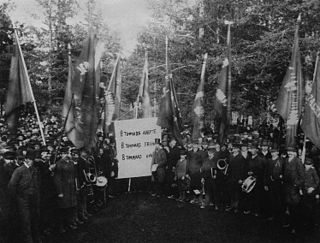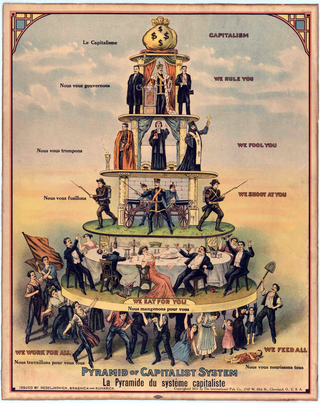
The Swedish Social Democratic Party, formally the SwedishSocial Democratic Workers' Party, usually referred to as The Social Democrats, is a social democratic political party in Sweden. The party is member of the Progressive Alliance and the Party of European Socialists.

The Swedish Trade Union Confederation, commonly referred to as LO, is a national trade union centre, an umbrella organisation for fourteen Swedish trade unions that organise mainly "blue-collar" workers. The Confederation, which gathers around 1.5 million employees out of Sweden's 10 million people population, was founded in 1898 by blue-collar unions on the initiative of the 1897 Scandinavian Labour Congress and the Swedish Social Democratic Party, which almost exclusively was made up by trade unions. In 2019 union density of Swedish blue-collar workers was 60%, a decline by seventeen percentage points since 2006 when blue-collar union density was 77%. A strong contributing factor was the considerably raised fees to union unemployment funds in January 2007 made by the new centre-right government.

The Central Organisation of Swedish Workers is a Swedish syndicalist trade union federation. The SAC organises people from all occupations and industries in one single federation, including the unemployed, students, and the retired. The SAC also publishes the weekly newspaper Arbetaren, owns the publishing house Federativ and ran the unemployment fund Sveriges Arbetares Arbetslöshetskassa (SAAK).

Saltsjöbaden is a locality in Nacka Municipality, Stockholm County, Sweden with 9,491 inhabitants in 2010. It is on the Baltic Sea coast, deep in the Stockholm Archipelago.

August Lindberg was a Swedish trade union organizer. He was a sawmill worker by profession, and belonged to the Swedish Saw Mill Industry Workers Union. Lindberg was chairman of the Swedish Trade Union Confederation from 1936 to 1947. He was also a member of the Swedish Social Democratic Party.

The labour movement in Sweden dates back to at least the 1850s, when Swedish workers initiated the organizing of previously spontaneous food riots into strikes, hence acting as an autonomous group.
The Syndicalist Workers' Federation was a Swedish anarcho-syndicalist trade union centre from 1928 to 1938.

The Swedish general strike of August 4 to September 6, 1909, was a general work stoppage by over 300,000 individuals all over Sweden. It was the first major conflict between the Swedish Trade Union Confederation, and the Swedish Employers Association. The losses to employers was estimated to be around 25 million Swedish kronor.

The Saltsjöbaden Agreement is a Swedish collective agreement signed between the Swedish Trade Union Confederation and the Swedish Employers Association on 20 December 1938, that became a model for other agreements. The rules on industrial action have come to be regarded almost as general legal principles of industrial conflicts between the labour market forces. The agreement cemented the Swedish social norm that the two sides shall conclude agreements without interference by government. The agreement is still in effect, with the latest changes being made in 2022.
The Women's Trade Union was a trade union in Sweden organizing female workers between 1902 and 1909. Its members were generally seamstresses, but the union also had a presence in other women-dominated sectors. In the year of its foundation, the union had 642 members. As of 1906, the union had 32 sections with a combined membership of 1,037.
Farm Workers Union of Central Sweden was a trade union for agricultural workers in Sweden. The organization was active between 1906 and 1908. Carl Albert Svedberg was the chairman of the Farm Workers Union of Central Sweden. As of September 1907 the union had around one hundred local sections. The membership of the Farm Workers Union of Central Sweden was to a large extent concentrated to certain large agricultural estates. The key areas of activities of the union were located around Mälaren. The organization also established its presence in Västergötland, Östergötland, Dalarna and Gästrikland.
The Swedish Saw Mill Industry Workers Union was a trade union of saw mill workers in Sweden. The union was founded in 1891, it was initially known as Svenska sågverks- och brädgårdsarbetareförbundet.

Karl-Petter "Kålle" Thorwaldsson is a Swedish union leader and politician who has served as Minister for Business, Industry and Innovation since November 2021. He was previously president of the Swedish Trade Union Confederation from 2012 to 2020.

Fredrik Olsen Aarnseth was a Norwegian-born Swedish politician and a member of the Swedish Social Democratic Party.

The Pyramid of Capitalist System is a common name of a 1911 American cartoon caricature critical of capitalism, copied from a Russian flyer of c. 1901. The graphic focus is on stratification by social class and economic inequality. The work has been described as "famous", "well-known and widely reproduced". A number of derivative works exist.

Arbetarhistoria is a quarterly magazine on labour history published by the Swedish Labour Movement Archives and Library. It was established in 1977 as Meddelande från Arbetarrörelsens arkiv och bibliotek and obtained its current name in 1984. It is targeted both at academics and the interested public. It is based in Huddinge.

Stig Nils Åke Malm was a Swedish trade unionist and politician. He was chairman of the Swedish Trade Union Confederation in 1983–1993.

Tesla, Inc. is an American electric car manufacturer which employs over 140,000 workers across its global operations as of January 2024, almost none of which are unionized. Tesla CEO Elon Musk has commented negatively on trade unions in relation to Tesla. Despite allegations of high injury rates, long hours, and below-industry pay, efforts to unionize the workforce have been largely unsuccessful. There are active labor disputes with Tesla in the United States, Germany and Sweden.
In 1980, a number of labour strikes, labour disputes, and other industrial actions occurred.














